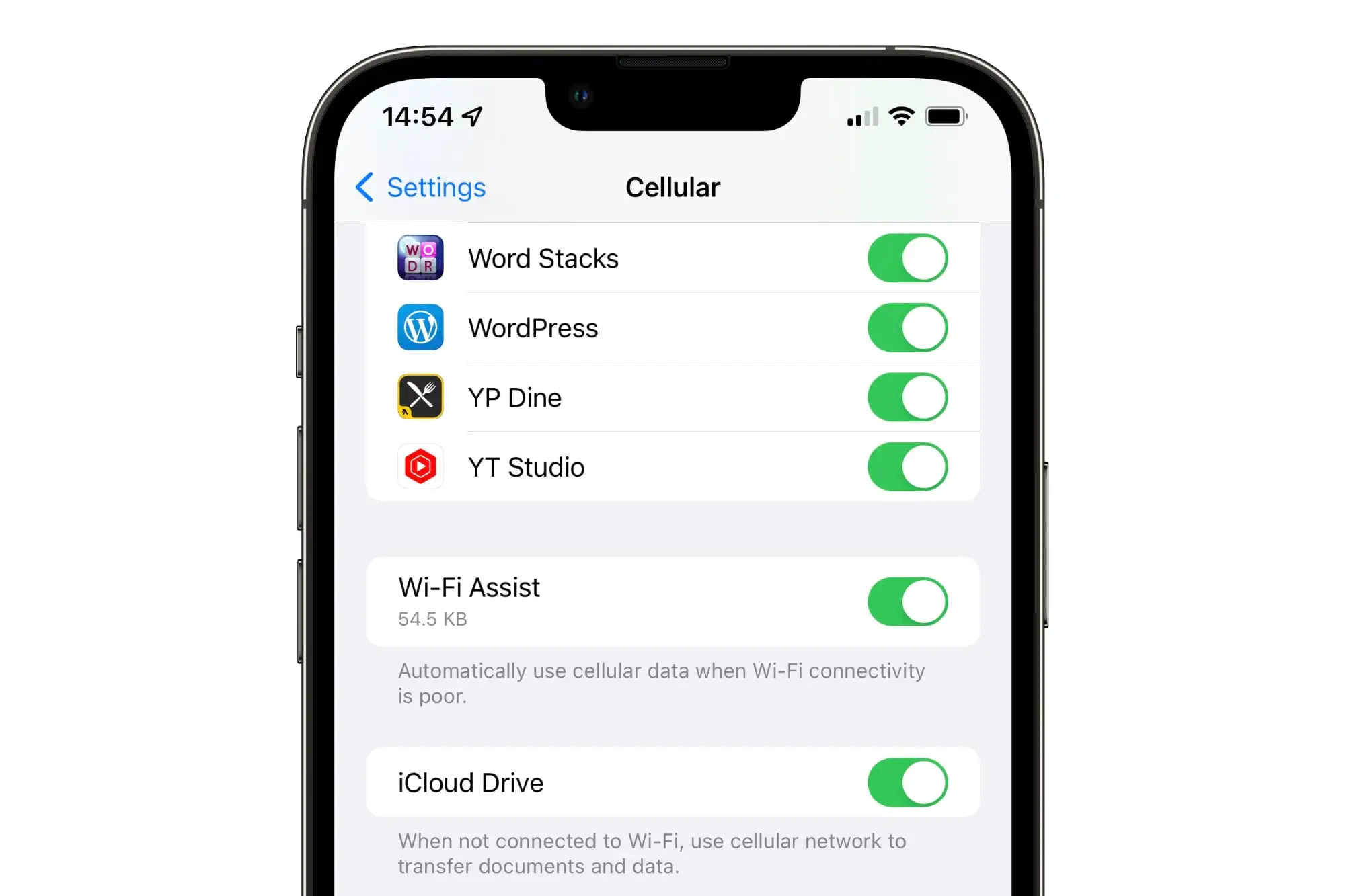What is WiFi Assist on iPhone 13?
WiFi Assist is a feature on iPhone 13 that automatically switches to cellular data when the WiFi connection is weak. This functionality aims to provide a seamless internet experience by preventing interruptions caused by a poor WiFi signal. When enabled, WiFi Assist ensures that users stay connected and can continue browsing, streaming, or using apps without experiencing significant lag or buffering.
The iPhone 13's WiFi Assist is designed to be a helpful tool, especially in situations where the WiFi signal is unstable or slow. It works in the background, monitoring the strength of the WiFi connection and seamlessly transitioning to cellular data when necessary. This can be particularly beneficial in crowded areas, such as public spaces or events, where WiFi networks may become congested and less reliable.
By automatically switching to cellular data, WiFi Assist aims to maintain a consistent and uninterrupted internet connection, allowing users to stay connected and productive. This feature reflects Apple's commitment to enhancing user experience by addressing common connectivity issues and ensuring a smooth online experience.
In essence, WiFi Assist on iPhone 13 acts as a safety net, stepping in to maintain a reliable internet connection when the WiFi signal weakens. While this can be advantageous in many scenarios, some users may prefer to have more control over their data usage and connectivity preferences, prompting them to consider disabling WiFi Assist to avoid unexpected data consumption.
Why Disable WiFi Assist on iPhone 13?
Disabling WiFi Assist on iPhone 13 can be a strategic decision for users who prefer to have more control over their data usage and connectivity preferences. While WiFi Assist is designed to seamlessly switch to cellular data when the WiFi signal weakens, there are several reasons why individuals may opt to disable this feature.
1. Data Usage Concerns
WiFi Assist may lead to increased cellular data usage, especially in situations where the WiFi signal fluctuates frequently. This can potentially result in higher data charges for users with limited data plans. By disabling WiFi Assist, individuals can proactively manage their data consumption and avoid unexpected spikes in cellular data usage.
2. Cost Management
For users mindful of their cellular data costs, disabling WiFi Assist can serve as a proactive measure to control expenses. By relying solely on WiFi connections and manually managing the transition to cellular data, individuals can effectively monitor and regulate their data usage, thereby avoiding unnecessary charges.
3. Preference for Manual Control
Some users may simply prefer to have full control over when their device switches to cellular data. By disabling WiFi Assist, individuals can consciously decide when to rely on cellular data, ensuring that they are aware of their data consumption patterns and can make informed choices regarding connectivity.
4. Network Stability
In certain scenarios, users may find that their WiFi network, while weak, is still preferable to cellular data due to factors such as network speed, reliability, or security. By disabling WiFi Assist, individuals can maintain a consistent connection to their preferred WiFi network, even if the signal strength fluctuates.
5. Privacy and Security
For individuals who prioritize the security of their data, disabling WiFi Assist can be a way to minimize reliance on cellular data and reduce exposure to potential security risks associated with public networks. By consciously opting for WiFi over cellular data, users can exercise greater control over their data privacy and security.
In summary, while WiFi Assist offers the convenience of seamless connectivity, there are valid reasons for users to consider disabling this feature. By doing so, individuals can actively manage their data usage, control costs, maintain network stability, and prioritize their privacy and security. Ultimately, the decision to disable WiFi Assist on iPhone 13 is a personal choice that aligns with individual preferences and priorities.
How to Disable WiFi Assist on iPhone 13
Disabling WiFi Assist on iPhone 13 is a straightforward process that allows users to take control of their data usage and connectivity preferences. By following these simple steps, individuals can effectively manage their device's behavior when transitioning between WiFi and cellular data.
-
Accessing Settings: Begin by unlocking your iPhone 13 and navigating to the home screen. Locate and tap on the "Settings" app, which is represented by a gear icon. This will open the device's settings menu, providing access to various configuration options.
-
Selecting Cellular: Within the Settings menu, scroll down and tap on "Cellular." This section allows users to manage their cellular data settings, including the option to disable WiFi Assist.
-
Disabling WiFi Assist: Upon entering the Cellular settings, locate the "WiFi Assist" option. It is typically positioned towards the bottom of the screen. To disable WiFi Assist, simply toggle the switch next to the WiFi Assist option to the off position. This action effectively turns off the feature, preventing the iPhone 13 from automatically switching to cellular data when the WiFi signal weakens.
-
Confirmation: After disabling WiFi Assist, it is advisable to verify the change by ensuring that the toggle switch next to the WiFi Assist option remains in the off position. This step provides reassurance that the feature has been successfully disabled and that the device will no longer automatically transition to cellular data based on WiFi signal strength.
-
Monitoring Data Usage: With WiFi Assist disabled, users can actively monitor their data usage and connectivity behavior, allowing for greater control over when the device switches to cellular data. By regularly reviewing data usage patterns, individuals can make informed decisions about their connectivity preferences and ensure that they stay within their data limits.
By following these steps, iPhone 13 users can effectively disable WiFi Assist, empowering them to manage their data usage and connectivity preferences with greater control and awareness. This simple adjustment provides individuals with the flexibility to prioritize their network stability, manage costs, and maintain privacy and security while using their device.
Alternative Solutions to WiFi Assist on iPhone 13
-
Manual WiFi Management: Instead of relying on WiFi Assist, users can manually manage their WiFi connections. By accessing the WiFi settings on their iPhone 13, individuals can prioritize and connect to preferred networks, ensuring a stable and reliable connection without the need for automatic transitions to cellular data.
-
Data Usage Tracking: Utilizing built-in data usage tracking features on the iPhone 13 can provide valuable insights into data consumption patterns. By monitoring data usage, users can proactively manage their connectivity preferences and make informed decisions about when to utilize cellular data, thereby reducing reliance on WiFi Assist.
-
WiFi Network Optimization: Optimizing WiFi networks at home, work, or other frequently visited locations can enhance the overall connectivity experience. By addressing WiFi signal strength and network stability through equipment upgrades or repositioning, users can minimize the need for automatic transitions to cellular data, reducing reliance on WiFi Assist.
-
Data Plan Evaluation: Reviewing and potentially adjusting cellular data plans can align data allowances with individual usage patterns. By selecting a data plan that accommodates typical data consumption, users can mitigate concerns about increased cellular data usage resulting from WiFi Assist, thereby reducing the need to disable the feature.
-
App-Specific Data Controls: Some apps offer specific settings to control data usage, such as limiting background data usage or enabling data-saving modes. By leveraging these controls within apps, users can manage data consumption on a per-app basis, reducing the impact of WiFi Assist on overall cellular data usage.
-
Network Connectivity Awareness: Developing an awareness of network connectivity in various environments can empower users to make informed decisions about when to rely on WiFi or cellular data. By recognizing patterns in network performance, individuals can strategically manage their connectivity preferences and reduce dependence on WiFi Assist.
By exploring these alternative solutions, iPhone 13 users can effectively address concerns related to WiFi Assist while maintaining control over their data usage and connectivity preferences. These proactive measures enable individuals to optimize their network experience, manage data consumption, and make informed decisions about when to utilize cellular data, ultimately reducing reliance on WiFi Assist.


